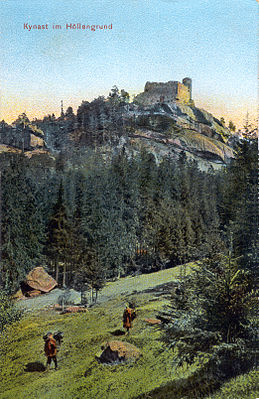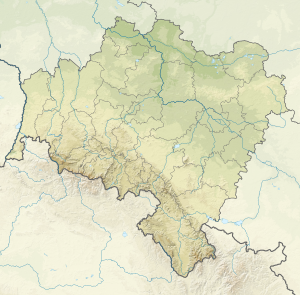Chojnik Castle
| Chojnik Castle | ||
|---|---|---|
|
The Kynastburg in the early 20th century |
||
| Alternative name (s): | Kynastburg | |
| Creation time : | 1292 | |
| Castle type : | Hilltop castle | |
| Conservation status: | ruin | |
| Place: | Jelenia Gora | |
| Geographical location | 50 ° 49 '59 " N , 15 ° 38' 48" E | |
| Height: | 627 m npm | |
|
|
||
The ruins of the Chojnik Castle (German Kynastburg , also the Kynast ) is a former castle complex near Sobieszów ( Hermsdorf under the Kynast ), now part of Jelenia Góra (Hirschberg) . It belonged to the Duchy of Schweidnitz-Jauer and from 1825 was part of the Kynast class . The legends and myths about the Kynast Castle served several writers as a template for writing.
Geographical location
Chojnik Castle is located in the Hirschberg Valley at the foot of the Giant Mountains . It lies on the top of the wooded Chojnik (Kynast) , a 627 meter high granite rock. On its southeast side there is a 150 meter steep slope down into the so-called Höllental. The castle belongs to the area of a nature reserve , which is an exclave of the Giant Mountains National Park (Karkonoski Park Narodowy) .
history
Chojnik Castle was probably built in 1292 by the Schweidnitzer Duke Bolko I as a border fortress towards Bohemia . His grandson Bolko II built a stone castle here in the 1350s. It was first mentioned in documents in 1364 as "Kinast". At that time it belonged to the later governor of Breslau Thimo III as a pledge . von Colditz , but fell back to Duke Bolko II after a short time. After his death in 1368, the Duchy of Schweidnitz fell under inheritance law to the Crown of Bohemia , with his widow Agnes von Habsburg being entitled to a lifelong usufruct . In 1381 she handed over the Kynastburg to the knight Gotsche Schoff, the founder of the Schaffgotsch family , as a fief . He is said to have been in high favor with both Duke Bolko II and Duchess Agnes and had already received the Hirschberger Landvogtei from the Duchess in 1375 . The Schaffgotsch were one of the most powerful noble families in Silesia and Bohemia. Later 16 estates belonged to the Kynast rule, including Hermsdorf , Herischdorf , Petersdorf , Schreiberhau and Warmbrunn .
As early as 1393 Gotsche Schoff began building the castle chapel made of red sandstone, which formed a bay window above the gate entrance. The construction was probably finished in 1405 and shortly thereafter the further expansion of the fortress began. At the beginning of the 15th century, the attacks of the invading Hussites were effectively repulsed from the castle . A short time later, the castle was a notorious robber baron's nest . From here the population of the area as well as the passing merchants were plundered. Ulrich von Schaffgotsch († 1543) united the dominions of Kynast and Greiffenstein in 1511 .
In the first half of the 16th century, the castle was expanded and fortified at the same time under Hans Ulrich von Schaffgotsch . During the Thirty Years' War , Hans Ulrich von Schaffgotsch served as a general in Albrecht von Wallenstein's Imperial Army . When the emperor lost confidence in his general, Hans Ulrich was arrested in 1634 and beheaded a year later for treason. All goods of the Schaffgotsch family were confiscated. Before the end of the war, the imperial family occupied Kynast Castle under the command of Rudolf Hieronymus Eusebius von Colloredo-Waldsee , who defended them against attacks by the Swedes. After the end of the war in 1648, Hans Ulrich's son Christoph Leopold von Schaffgotsch was taken over by Emperor Ferdinand III in 1649 . appointed Silesian senior councilor. A year later he got his possessions back. During a storm on August 31, 1675, lightning struck the castle, which then burned down completely. A reconstruction was not undertaken, so that the ruins of the castle became deserted. After the First Silesian War , Kynsburg fell to Prussia along with most of Silesia .
Since the ruins became a tourist attraction in the early 19th century (including the Prussian royal family, Heinrich von Kleist , Johann Wolfgang von Goethe and Theodor Körner ), the Schaffgotschs built a restaurant and a mountain guide base in 1822. Three years later, they rebuilt the tower.
As a result of the Second World War, the ruins of the Kynastburg fell to Poland in 1945, like almost all of Silesia. The Schaffgotsch family was expropriated. In 1960 the building of the Polish Association for Tourism and Regional Studies was opened in the converted north bastion , and it is still in operation today. In 1964 the castle was completely repaired. Since the early 1990s, the fortress has served as the seat of the Chojnik Castle Knight Brotherhood.
Castle complex
The defense structure was built on a square base with a length of 20 meters and a width of 10 meters. The north-western part was completely taken up by the residential building, from which the walled courtyard extended to the east. The entire system was closed off by the round defense tower from the east and the gate entrance on the north side.
Around 1405 Gotsche Schoff II laid the foundation stone for the chapel of St. George and St. Catherine , which was built in the form of a bay window above the gate entrance. The castle courtyard was significantly expanded in the first half of the 15th century: In the middle of the castle courtyard there was a stone damming column , which is dated to the year 1410 and which has been preserved to this day. The next extensions followed at the beginning of the 16th century. An extensive lower castle was built on the northeast side, which was mainly occupied by farm buildings.
The accommodation for the crew and the kitchen bordered the eastern part of the walls; the debate room was built in the north corner. There was no possibility of digging a castle well on the castle grounds , which is why rock cisterns were built to collect rainwater in both the lower and the upper courtyard . In 1560 the elongated north bastion was built and around the same time the main gate with the drawbridge; the stable was close to the gate. The masonry was embellished with a Renaissance attica.
In the 1740s, when the castle was captured by the imperial army , further fortifications were made. In the north-western part a bastion was built , which formed the next line of defensive walls and the gate bastion on the western side. In the castle courtyard mentioned above, quarters for the commandant were built next to the main gate.
Legends and myths
The most famous legend associated with the Kynastburg is the story of the beautiful Princess Kunigunde , the daughter of the wealthy lord of the castle. Many important knights who came to the castle asked for her hand , but the princess set a condition for every applicant. She would become his wife, who rides in full armor on his horse around the castle walls. Everyone knew that this requirement was almost impossible to meet because of the steep slope of the mountain, but many a knight had tested his strength. All perished as they fell into the abyss, and the wiser gave up in time.
Many years passed and many young men lost their lives until the Landgrave of Thuringia appeared at the castle, who immediately pleased Kunigunde. She even wanted to forego the fatal test because of him, but the proud daredevil, sitting in the saddle, accepted the challenge. He rode around the castle and his horse kept up the steep path. The fanfares rang out and the princess ran out to fall around his neck. However, he replied that he had long been married and would never touch her bloody hand. Thereupon he rode away and the princess threw herself into the mountainous abyss, since she could not bear the humiliation. According to a second version of the legend, she went to a monastery and died after a short time of a broken heart; according to a third version, she married on the recommendation of Landgrave Knight Hugo von Erbach, had the wall demolished and atoned for her sacrilege.
The legend has been handed down u. a. in the collections of Johann Gustav Büsching ("Folk Tales, Fairy Tales and Legends", 1812), Ludwig Bechstein ("German Sagenbuch", 1853) and Johann Georg Theodor Grasse ("Sagenbuch des Prussischen Staats", 1868/1871). Ludwig Bechstein ("The Wall Ride"), Theodor Körner ("The Kynast") and Friedrich Rückert ("The Welcome to the Kynast") took the legend as a template for ballads . In the poem "Auf dem Kynast" the women's rights activist Louise Otto-Peters portrays Kunigunde as an emancipated woman.
Trivia
- Adam Chodyński wrote of the “ruins of the Kynast” (u ruin Kynastu) in his poem W zwaliskach (“in ruins”) in 1872 .
- Since 1991, the castle has held an annual crossbow tournament called O Złoty Bełt Zamku Chojnik ("For the Golden Bolt of the Kynastburg"), which has been held since 1993 by the Bractwo Rycerskie Zamku Chojnik ("Brotherhood of the Knights of the Kynastburg").
literature
- Hugo Weczerka (Hrsg.): Handbook of the historical places . Volume: Silesia (= Kröner's pocket edition . Volume 316). Kröner, Stuttgart 1977, ISBN 3-520-31601-3 , pp. 182-184 and 150.
- Günther Grundmann : Castles, palaces and manor houses in Silesia - Volume 1: The medieval castle ruins, castles and residential towers . Verlag Wolfgang Weidlich, Frankfurt am Main 1982, ISBN 3-8035-1161-5 , pp. 75-80.
- Karl August Müller: Patriotic images, in a history and description of the old castle festivals and knight castles of Prussia. Glogau 1837, pp. 440-489.
- Małgorzata Chorowska: Rezydencje średniowieczne na Śląsku. Zamki, pałace, wieże mieszkalne , Wrocław 2003, ISBN 83-7085-680-2 .
- Leszek Kajzer, Stanisław Kołodziejski, Jan Salm: Leksykon zamków w Polsce , Warszawa 2001, ISBN 83-213-4158-6 .
- Bohdan Guerquin: Zamki w Polsce , Warszawa 1984, ISBN 83-213-3239-0 .
Web links
- Jelenia Góra-Sobieszów - Zamek Chojnik (Polish)
- Illustration from 1838 by Heinrich Wilhelm Teichgräber ( digitized version )
- The saga of Kunigunde von Kynast in texts and pictures
- Homepage of the castle






